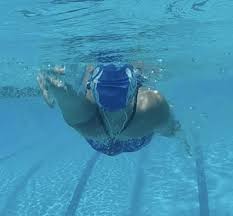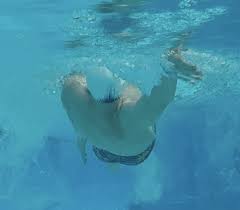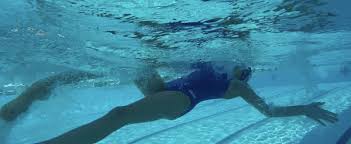Welcome back to the last and final segment of our Backstroke series. For today’s post, we are going to discuss the 4 MOST common Backstroke technique errors. If you haven’t read Part’s 1-3, I’d highly recommend going back and reading them. Here are the links:
Let’s get started…
There is NO doubt that Backstroke is a difficult stroke. As we discussed on Part I, even though you are proficient at Freestyle—it does not mean you’ll be good at Backstroke. The Backstroke stroke has a completely different pulling pattern with a little less rotation, all while being belly up. Because this stroke is unlike all the others, it has its’ own set of technical issues. Through the abundance amount of underwater video I’ve analyzed, I’ve created this list of the 4 MOST Common Backstroke Technique Errors.
Let’s start with #1!
1. The Cross-Over Entry

This technique error is something I’ve seen repeated over and over. And, it’s not an error specifically associated with a certain age or level—this error is something that has plagues many Backstrokers for decades.
During the cross-over entry, the hand that is entering into the water behind the head, actually over-reaches up top and crosses the swimmer’s midline (prior to entering the water). Part of the reason this error is so common is because when the hand is above the head, the swimmer cannot see their entry with their eyes. So while a swimmer may think they are entering right outside their shoulder joint—many times they have actually over-reached and crossed their midline.
What this entry does is it delays the time it takes for the swimmer to get into their catch. Plus, this entry position is also very stressful on a swimmer’s shoulders too.

The ideal entry is the pinky entering the water first with the palm facing away from the body—right outside the swimmer’s respective shoulder joint. Any sort of movement closer to the midline or further away from a swimmer’s body is NOT ideal.
2. Lack of Rotation

Just like the cross-over entry, not having enough rotation is another common technique error I’ve seen with many Backstrokers—no matter their age or ability level.
Without proper rotation, it’s actually very hard to get into a proper catch. If your body lays flat on the surface of the water and you put your hand above your head—ready to push water down, you actually have to put your shoulder into an EXTREME negative angle (to get your hand to pull below the surface of water), which DRASTICALLY increases your injury risk over time.
Also with minimal rotation, you don’t have any help from your lower back/core muscles to aid the propulsion generated from the pull. You are strictly relaying on your arms to generate all the propulsion and there your body is along for the ride.

The ideal amount of rotation in Backstroke is 30-degrees or less from the water’s surface. With the proper amount of rotation, your pull will be stronger, your frontal drag will decrease, and your tempo will increase. Make the change
3. The Deep Catch

Originally, Backstrokers were taught that the deeper their catch would be, the more water they can push backwards. On top of that, some Backstrokers were taught a pull with a wave-like pattern. This wave pulling pattern was taught in response to coaches and swimmer’s believing in the theory of “thrust”, which has turned out to be untrue and unfounded with swimming.
So while the theory behind a deep catch sounded great, it actually does NOT allow a swimmer to push more water. The ideal catch position is with the swimmer’s shoulder in line with their upper back, the elbow bent somewhere between 100-120 degrees, the hand beneath the surface somewhere between 4-8 inches, and the palm facing towards a swimmer’s feet.
All of the world’s fastest Backstrokers right now are using this shallow catch positioning, which in turn keeps their tempo high, their rotation fast, and water constantly being pushed at their feet.
4. Knees Breaking the Surface

This error is more specifically focused on younger swimmers and age-groupers. With Backstroke keeping the swimmer’s belly face up, it’s easy to spot a swimmer that is kicking with too much knee bend.
I’ve analyzed many videos of swimmer’s whose knees break the surface of the water. This excessive bending of the knee increases a swimmer’s frontal drag AND decreases the amount of propulsion they can generate from their kick.
The ideal body positioning is the majority of the body submerged right below the surface. With the Backstroke kick, a swimmer must bend their knee and bring their heel to their bum. From there, they actively plantarflexing their toes to unbend the knee and finish through with the kick with their toes (ONLY) breaking through surface.
Always think about kicking through your hips in Backstroke—not your knees. Every swimmer should finish their kick with a whipping-like motion!
It’s always easier to identify different technique errors when you know what to look for. With these 4 Most Common Backstroke Technique Errors, some of them–you can see from the surface and others—you can’t.
If you ever need help getting one of your swimmer’s strokes analyzed or your own personal stroke, we offer a few different package options. Be sure to visit: www.swimlikeafish.org/video for more information.
Thanks for tuning into our Backstroke series.
Until Next Time,
Abbie Fish

2 Responses
Hi
Excellent
Excellent
Excellent